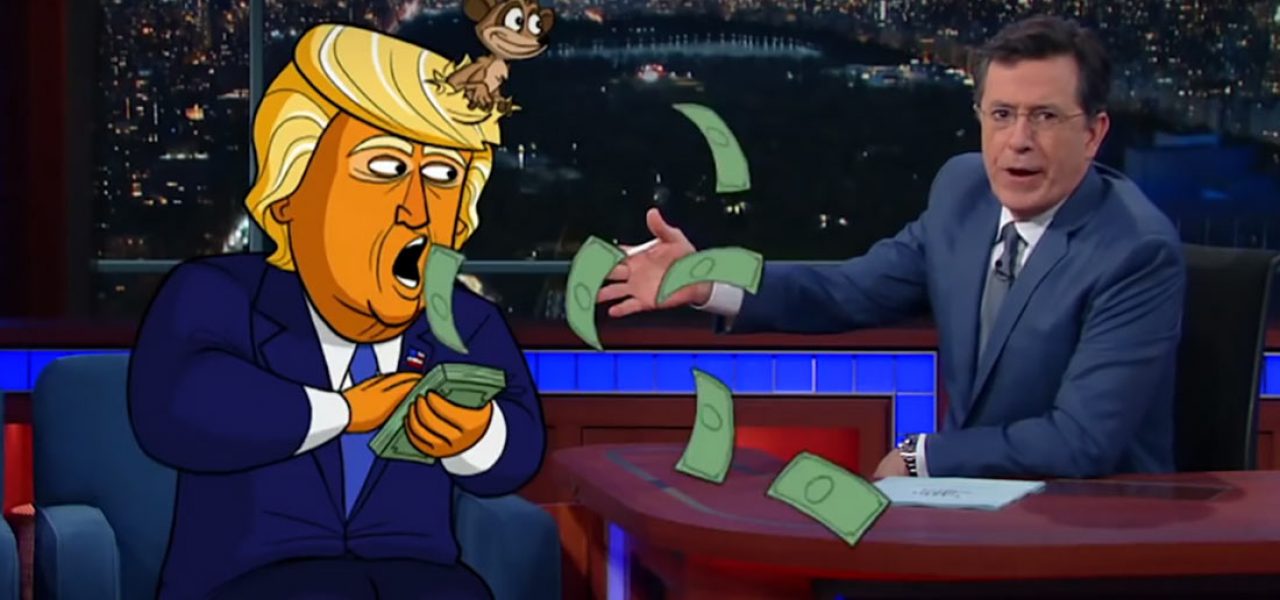

How President-Elect Donald Trump Was Animated in Real-Time With Adobe Character Animator
One of the animation highlights of the just-concluded election season was The Late Show with Stephen Colbert’s frequent conversations with Republican candidate (and as of last night, President-elect) Donald Trump—the cartoon version, that is. A frequent and hilarious guest, cartoon Donald has talked with Colbert about various issues in his campaign, including his contentious relationship with the media and his strategy to win over Sanders’ supporters.

Cartoon Donald Trump is the brainchild of lead animator Tim Luecke and senior digital producer and writer Rob Dubbin. Veterans of The Colbert Report, both have enjoyed creating something outside the realm of what people expect to see on television—real-time interaction with an animated character. Cartoon Brew spoke with them about how Adobe Character Animator helps them break new ground in late night television.
Cartoon Brew: How did you first get interested in working with Adobe Character Animator?
Tim Luecke: I’d been reading about Character Animator before the initial preview launch. As someone who used to build complex After Effects rigs to accomplish 2D animation, this sounded like a tool that would make my life easier. The day the first preview launched I downloaded it, rigged up some characters I’d animated in After Effects, and showed them around the office. Everyone was excited but we didn’t know what to do with it at the time. Six months later we decided to look into it again and it was exponentially more sophisticated.
Rob Dubbin: We started up a little skunkworks to figure out if it was something we could do on the live show. We looped in producers, crew, the control room, and the director to set up a cartoon that Stephen could interact with from his desk.
What were the previous challenges working with live animation?
Tim Luecke: On The Colbert Report, we always wanted to do animated bits, but they required so much preplanning and preproduction. We did one three-and-a-half minute short that took a few months to create. We had aspirations to do more, but it’s so hard to think ahead three days, let alone three months with late night TV.
Rob Dubbin: I worked on a series of cartoons on The Colbert Report that were tightly scripted and highly orchestrated. But whenever Stephen tried to interact with a cartoon, the delay between the animation and his jokes always bugged me. You just didn’t feel like the two characters were in the same room with each other.
When did you realize you could add live animation to the show?
Tim Luecke: The big breakthrough moment was when we figured out we could rig it so the character was actually in the physical studio space with Stephen live.
Rob Dubbin: In March, we came up with the silly idea of creating an Irish ancestor for Stephen to talk to. Tim rigged up a cartoon and we tested it in our spare time. It was successful in practice but didn’t end up airing for St. Patrick’s Day. We had a hiatus right after that and Tim took it upon himself to create a cartoon Donald Trump with his vacation time.
Tim Luecke: Brian Stack, one of our excellent writers who is also a voice actor and improviser, does a great Trump voice. It seemed like a good idea to have a cartoon Donald Trump at the ready for Stephen to talk to whenever he wanted. For me, it was largely an opportunity to dig deep into the program and see how sophisticated we could get with it.
What was the first animation you did on the show?
Tim Luecke: We did a live cartoon bird in one of the cold opens. We ran into a couple of glitches when streaming and the next day we contacted Dave Simons, one of the main creators of Character Animator. The team at Adobe responded quickly and offered help. They added us to the prerelease program and we’ve been working closely ever since to make sure we’re working on a build that will work the best for our needs. We did the cartoon bluebird on Monday and on Wednesday we did a full-fledged cartoon Donald Trump.
Tell us about the first cartoon Donald Trump segment.
Rob Dubbin: It all happened pretty quickly. I was in Tim’s office playing with the character and noticed that when you angled away toward the edge of the camera field the cartoon recoiled as if it were deathly afraid of something. In the news that day was a story about Trump’s security removing a reporter because she was holding a ball point pen that Trump speculated could have been a little bomb. I thought if we had Stephen hold a pen toward cartoon Donald Trump it would be fun to watch the cartoon recoil in fear.
Tim Luecke: We performed it in front of Stephen on a laptop with Brian doing Trump’s voice and one of the producers holding the pen. It got a good laugh and we made the decision to do it that day. It’s both weird and wonderful to have live physical comedy with a cartoon character.
What do you like about working with Adobe Character Animator?
Rob Dubbin: It’s really breathtaking to see the possibilities Character Animator opens up for someone like Tim, who is so talented and prolific. The software is a magnifier of his talent and ability to turn things around in a day. As a writer, I love the gestures. Brian does the voice and the shoulders and another writer does the control of the gestures, keyboard triggers, and whatever other surprises we have baked into the puppet. Watching the way a performer can use those expressively is enjoyable.
Tim Luecke: Character Animator gives us freedom to be really nimble and swift. Once you have a puppet you can try out a gesture in Adobe Photoshop CC and within five minutes see if it works in Character Animator. I feel like I’m building a cool toy; when I hand it off to the team they can spend 15 minutes and come up with something I’m not expecting them to do.
If needed, we can also rewrite a whole segment between rehearsal and taping and the cartoon will act accordingly. It’s been a perfect fit for this world of improvisation that we live in where things get changed at the last minute.
Is there anything that has surprised you in Character Animator?
Tim Luecke: As soon as I figured out you could do frame by frame animation and trigger it in the program live—that really made it invaluable. Recently we put a Rastafarian hat on Trump and the ease with which we could make the dreadlocks dangle and put physics on them was amazing. It makes it look like I’m doing something really cool, but I’m just using the dangle command in Character Animator!
What else do you have planned leading up to the election?
Tim Luecke: We recently introduced Cartoon Hillary Clinton during our live DNC shows. It was very nerve-wracking from a production standpoint, because it was the first time we used Character Animator to do a live-to-air bit. But it worked great. Half an hour before we went live, Bill Clinton made a speech that drew a contrast between the “real” Hillary Clinton and the “cartoon” version of her. Thankfully, I’d been working on a Cartoon Hillary, and we had a writer, Jen Spyra, who could do the voice, so we got to comment on the speech less than an hour after Bill delivered it. The audience loved it.
What does Stephen think of these special guests?
Rob Dubbin: His joy interacting with a cartoon that is both in front of him and not in front of him is palpable. He thrives on that sort of thing.
Tim Luecke: We got some big hugs!
